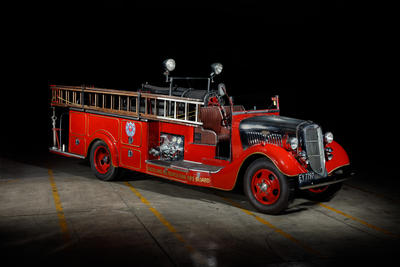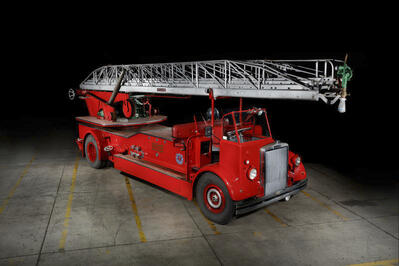Fire Engine [Ford V8 Auckland Metropolitan Fire Board]
Maker and role
Ford Motor Company of Canada Limited, Manufacturer
Colonial Motor Company, Assembler
Cavanagh and Company Limited, Builder
Auckland Metropolitan Fire Board, Commissioned by
Production date
1935
See full details
Object detail
Type: Pumping appliance
Manufacturer: Ford (Canada), imported by Colonial Motor Company Limited (abbr. Colmoco, Wellington)
Engine and output: V8, 3.6 litre, outputting 48-56 kw
Gearbox: 4-speed manual
Pump: Colmoco pump capable of delivering 180 per minute
Crew: Up to 8 fire personnel
The chassis from this engine is of Canadian manufacture and was assembled in Wellington by Ford Canada franchisee Colonial Motor Company, who also supplied the pump for the engine. The bodywork was built in Auckland by coach building company Cavanagh (est. 1922). When put into service, the engine featured notable differences from previous machines operated by Auckland’s fire services. The centrifugal pump is transversely located behind the gearbox, instead of at the rear of the chassis, and could pump 1800 litres (400 gallons) of water per minute. Its basic operating principle is that it uses centrifugal energy to increase the speed and pressure of fluid passed through it, making it ideal for fire response.
There was also accommodation for up to 8 firefighters who could sit inside a well in the vehicle and face each other. This posed less risk than standing on the side of a fire engine, given these engines could achieve faster speeds with the introduction of pneumatic tyres (inflated rubber) in the 1930s. The New Zealand Herald also reported an improvement in the appliance’s ability to discharge hoses from the rear, so that they could be paid out as the engine approached the scene of a fire.
This vehicle served for many years also known as the ‘Flyer,’ a service term for the first engine out of the Headquarters Station. The flying squad was a feature of Auckland Central’s service for many years and could be relied upon to turn out in under 25 seconds day or night. It stayed as the no. 1 pump at the Pitt Street Station for 15 years, before it moved in 1954 to Ōtāhuhu as their no. 2 pump. It went back to Auckland’s headquarters in 1960, where it was converted to a foam tender to pump foam into fires that involved flammable liquids. In 1965 the engine was sold to the North Shore Fire Board and operated out of Devonport until 1974. It was donated to MOTAT by the North Shore Fire Board in 1974.
AUCKLAND METROPOLITAN FIRE BOARD Logo



Public comments
Be the first to comment on this object record.